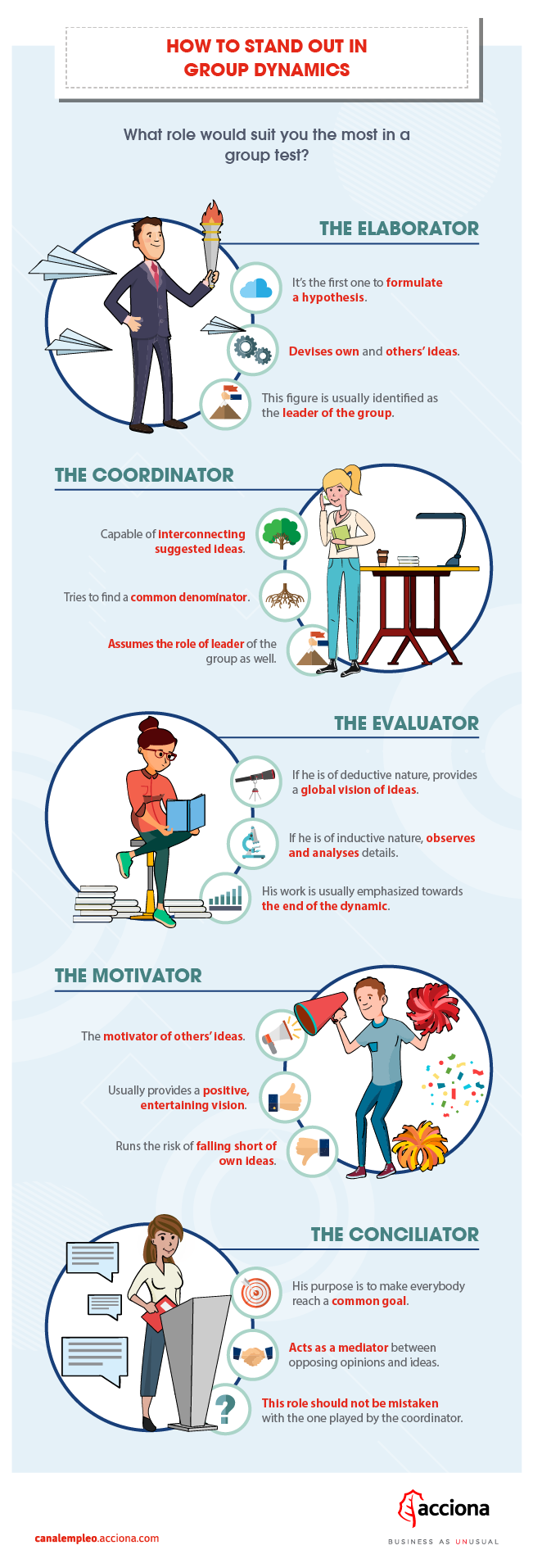This article is all about group dynamics, but first of all we’d like to explain the relevance of knowing their mechanics by answering the following question: Is being the best just being ‘the best’?
No. Nowadays, being the best in your field is not enough to become ‘the best’ . The labour market is an increasingly competitive world, with multitude of qualified, motivated professionals willing to stand out at workfrom the crowd. Therefore, the number of companies seeking both the best professional aptitudes and attitudes within working environments is rising. And there’s nothing better to discern this than including group dynamics in selection processes. You must be aware of this increasingly imaginative practice if you’re applying for a job.
Learn, understand, evolve
Meanwhile, companies are becoming more aware of the importance of team working, the rise in productivity associated to fostering a good working environment, and that having true leaders among employees capable of improving their colleagues’ working capacity is pivotal.
As professionals, our natural aspiration can be summarized in these three words: learn, understand and evolve. It’s inherent to human beings to seek improvement, be it by getting a promotion, better salary conditions or by taking a remarkable professional leap.
Hence, what this business transformation entails for all those immersed in this evolving process is the need to develop, in addition to all those related to their field, other professional skills such as teamworking, leadership abilities or talent when innovating.
The solution: group dynamics
All these qualities are embodied in something as simple as group dynamics. These activities, besides refreshing work environments, allow to work on communication, teamwork or temper under stressful situations, apart from establishing different latent roles (leader, facilitator, fixer…) within the group.
Below are some of the most funny, competitive, original group dynamics used by large companies all over the world. And remember that if you offer your team to engage in these activities, you’ll be playing the card of communication, initiative and creativity.
Some examples of group dynamics
Practical case, real effects
One of the classic tests still ruling group dynamics. Solving a case study is directly related to working skills such as empathy, creativity, analysis, leadership or problem-solving capacity.
A group dynamic comprised of as many participants as needed according to the roles required to address the problem. A time restriction. Pencil, paper, plasticine, watercolours… imagination is the limit. The team will deal with the situation, revealing certain characteristics of its members: the conductor, the loner, the creative one, the helper… is your role in the team related to what you have showcased during the group dynamics?
It’s a way to apply our routinely professional skills to a problem ‘outside the box’. Another interesting case is when we swap roles with every participant: one becomes the company, one becomes the customer, another one becomes the vendor… This way new perspectives arise on issues that seemed unsolvable.
Building a bridge
The purpose of this group dynamic is to analyze every member’s role in order to achieve the goals and any group conflict that may arise. In order to perform this dynamic, the group is divided in two teams. Each one of them will have to build half a bridge. Teams will be allowed to speak among themselves, but they won´t be seeing each other at all, and they’ll have the exact same materials to perform the activity.
Once time is finished, both teams should bring ideas together. If the bridge is solidly built, what kind of obstacles were detected during the construction process and how did they solve them? If, on the contrary, they’re not capable of achieving the final goal, the question will be: why do you think you did not meet the objective?
In both cases, it’s interesting that they reflect on how they were capable of communicating properly just by using spoken language. Lastly, how were the dynamics developed in each team? how were roles assigned? was there a unique leader or more than one?
Sitting on the restaurant
In this instance, apart from analysing the roles assumed by each participant, the objective of the group dynamic is to monitor whether said roles vary or remain unaltered.
The group is divided in teams of 5-6 people. Each team will be handed a riddle, and the final answer must be consensual and supported, at least partially, by each member. In this simple manner, every group will engage in an intense debate during which leaders and opposers will clash, and they’ll have to find common ground.
When handing the answer back, final thoughts must provide a response to the following questions: how was consensus reached? how were disagreeing group members convinced? did they feel pressured? how was the process within each team? did they feel constrained by time?
Blind doodling, an example of group dynamic
This group dynamic monitors the way each team member communicates, provides guidance and expresses his opinions. This way, it’s possible to establish an effective line of communication.
The first thing is to divide participants in two groups. Each group will have a cardboard with a house outlined. Participants will have to complete the details of the house with their eyes blinded. For that to be achieved, the remaining members of the team will have to guide their colleague.
When time is up, teams will bring drawings together and evaluate whether the objective is achieved. At this moment, the following questions will be posed: what kind of obstacles did they find? how did they overcome them? were there any strategy changes? how did collaboration with other participants help overall?
And remember…
There are thousands of assessment techniques within a group dynamic. Here we have mentioned some of the most common, but large companies usually have their own. You only have to follow a principle: try to stand out for your strengths, your best capabilities and your professional skills(enlace interno a contenido relacionado). That way you will attract attention in a positive fashion.
One last tip: group dynamics are a tool to have a good time and grow professionally. Respect other opinions, advices and methodologies. As the saying goes, You can learn from everything!
Sources: El País, Bizneo, Dinámicas grupales



